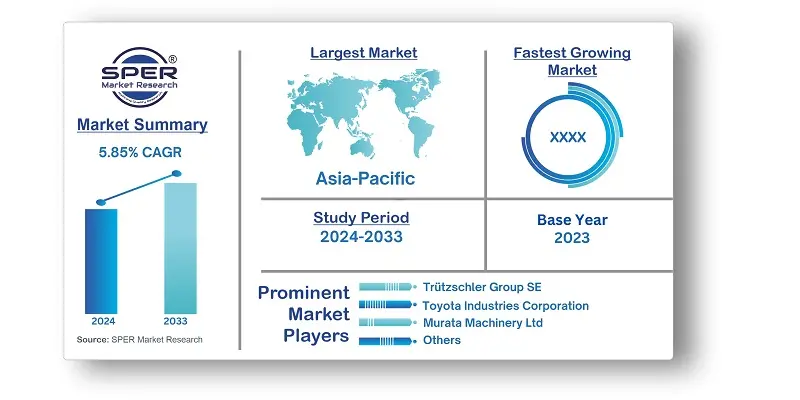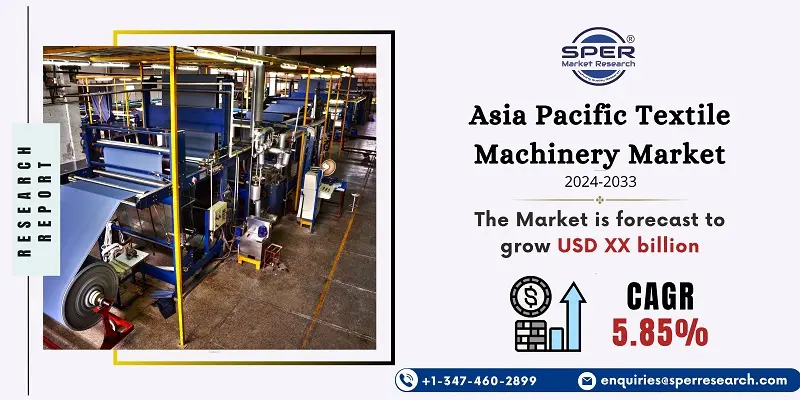
Asia Pacific Textile Machinery Market Trends, Growth, Size, Demand, Revenue and Future Outlook
Asia Pacific Textile Machinery Market Growth, Trends, Analysis, Size- By Machine Type, By Distribution Channel, By Application- Regional Outlook, Competitive Strategies and Segment Forecast to 2033
| Published: Aug-2024 | Report ID: MACH2431 | Pages: 1 - 159 | Formats*: |
| Category : Equipment and Machinery | |||
- Trützschler Group teamed up with Texnology in 2022 to launch T-SUPREMA. This is a manufacturing line that uses steel needle web bonding to create technical textiles like geotextiles, automobile fabrics, and filters.
- In 2021, Mayer Braidtech, a wholly owned subsidiary of the corporation, announced a cooperation with Mayer & Cie. GmbH & Co. KG, based in Albstadt. This collaboration represented the formal culmination of Mayer Braidtech GmbH's incorporation into the company's headquarters in Albstadt, bolstering its position as a manufacturer of circular knitting machines.


| Report Metric | Details |
| Market size available for years | 2020-2033 |
| Base year considered | 2023 |
| Forecast period | 2024-2033 |
| Segments covered | By Machine Type, By Distribution Channel, By Application |
| Regions covered | China, Japan, India, South Korea, Australia, Indonesia and Others |
| Companies Covered | A.T.E Private Limited, Trützschler Group SE, VANDEWIELE NV, Rieter Holding Ltd, Lakshmi Machine Works Limited, Murata Machinery Ltd, LONATI SPA, Tessenderlo Group nv, Mayer & Cie GmbH & Co KG, Toyota Industries Corporation. |
- Textile Manufacturers
- Machinery Manufacturers and Suppliers
- Investors and Financial Institutions
- Government Bodies and Regulators
- Research and Development (R&D) Institutions
- Trade Associations and Industry Bodies
- Consulting and Market Research Firms
- Educational Institutions
| By Machine Type: | |
| By Distribution Channel: | |
| By Application: |
- Asia Pacific Textile Machinery Market Size (FY’2024-FY’2033)
- Overview of Asia Pacific Textile Machinery Market
- Segmentation of Asia Pacific Textile Machinery Market By Machine Type (Spinning Machines, Weaving Machines, Knitting Machines, Texturing Machines, Others)
- Segmentation of Asia Pacific Textile Machinery Market By Distribution Channel (Direct, Indirect)
- Segmentation of Asia Pacific Textile Machinery Market By Application (Garments and Apparels, Household and Home Textiles, Protective Textiles, Medical, Automotive, Others)
- Statistical Snap of Asia Pacific Textile Machinery Market
- Expansion Analysis of Asia Pacific Textile Machinery Market
- Problems and Obstacles in Asia Pacific Textile Machinery Market
- Competitive Landscape in the Asia Pacific Textile Machinery Market
- Impact of COVID-19 and Demonetization on Asia Pacific Textile Machinery Market
- Details on Current Investment in Asia Pacific Textile Machinery Market
- Competitive Analysis of Asia Pacific Textile Machinery Market
- Prominent Players in the Asia Pacific Textile Machinery Market
- SWOT Analysis of Asia Pacific Textile Machinery Market
- Asia Pacific Textile Machinery Market Future Outlook and Projections (FY’2024-FY’2033)
- Recommendations from Analyst
1.1. Scope of the report1.2. Market segment analysis
2.1. Research data source
2.1.1. Secondary Data2.1.2. Primary Data2.1.3. SPER’s internal database2.1.4. Premium insight from KOL’s
2.2. Market size estimation
2.2.1. Top-down and Bottom-up approach
2.3. Data triangulation
4.1. Driver, Restraint, Opportunity and Challenges analysis
4.1.1. Drivers4.1.2. Restraints4.1.3. Opportunities4.1.4. Challenges
4.2. COVID-19 Impacts of the Asia Pacific Textile Machinery Market
5.1. SWOT Analysis
5.1.1. Strengths5.1.2. Weaknesses5.1.3. Opportunities5.1.4. Threats
5.2. PESTEL Analysis
5.2.1. Political Landscape5.2.2. Economic Landscape5.2.3. Social Landscape5.2.4. Technological Landscape5.2.5. Environmental Landscape5.2.6. Legal Landscape
5.3. PORTER’s Five Forces
5.3.1. Bargaining power of suppliers5.3.2. Bargaining power of buyers5.3.3. Threat of Substitute5.3.4. Threat of new entrant5.3.5. Competitive rivalry
5.4. Heat Map Analysis
6.1. Asia Pacific Textile Machinery Market Manufacturing Base Distribution, Sales Area, Product Type6.2. Mergers & Acquisitions, Partnerships, Product Launch, and Collaboration in Asia Pacific Textile Machinery Market
7.1. Asia Pacific Textile Machinery Market Size, Share and Forecast, By Machine Type, 2020-20267.2. Asia Pacific Textile Machinery Market Size, Share and Forecast, By Machine Type, 2027-20337.3. Spinning Machines7.4. Weaving Machines7.5. Knitting Machines7.6. Texturing Machines7.7. Others
8.1. Asia Pacific Textile Machinery Market Size, Share and Forecast, By Distribution Channel, 2020-20268.2. Asia Pacific Textile Machinery Market Size, Share and Forecast, By Distribution Channel, 2027-20338.3. Direct8.4. Indirect
9.1. Asia Pacific Textile Machinery Market Size, Share and Forecast, By Application, 2020-20269.2. Asia Pacific Textile Machinery Market Size, Share and Forecast, By Application, 2027-20339.3. Garments and Apparels9.4. Household and Home Textiles9.5. Protective Textiles9.6. Medical9.7. Automotive9.8. Others
10.1. Asia Pacific Textile Machinery Market Size and Market Share
11.1. Asia Pacific Textile Machinery Market Size and Market Share By Region (2020-2026)11.2. Asia Pacific Textile Machinery Market Size and Market Share By Region (2027-2033)11.3. China11.4. Japan11.5. India11.6. South Korea11.7. Australia11.8. Indonesia11.9. Others
12.1. A.T.E. Private Limited
12.1.1. Company details12.1.2. Financial outlook12.1.3. Product summary12.1.4. Recent developments
12.2. Trützschler Group SE
12.2.1. Company details12.2.2. Financial outlook12.2.3. Product summary12.2.4. Recent developments
12.3. VANDEWIELE NV
12.3.1. Company details12.3.2. Financial outlook12.3.3. Product summary12.3.4. Recent developments
12.4. Rieter Holding Ltd
12.4.1. Company details12.4.2. Financial outlook12.4.3. Product summary12.4.4. Recent developments
12.5. Lakshmi Machine Works Limited
12.5.1. Company details12.5.2. Financial outlook12.5.3. Product summary12.5.4. Recent developments
12.6. Murata Machinery, Ltd
12.6.1. Company details12.6.2. Financial outlook12.6.3. Product summary12.6.4. Recent developments
12.7. LONATI SPA
12.7.1. Company details12.7.2. Financial outlook12.7.3. Product summary12.7.4. Recent developments
12.8. Tessenderlo Group nv
12.8.1. Company details12.8.2. Financial outlook12.8.3. Product summary12.8.4. Recent developments
12.9. Mayer & Cie GmbH & Co KG
12.9.1. Company details12.9.2. Financial outlook12.9.3. Product summary12.9.4. Recent developments
12.10. Toyota Industries Corporation
12.10.1. Company details12.10.2. Financial outlook12.10.3. Product summary12.10.4. Recent developments
12.11. Others
SPER Market Research’s methodology uses great emphasis on primary research to ensure that the market intelligence insights are up to date, reliable and accurate. Primary interviews are done with players involved in each phase of a supply chain to analyze the market forecasting. The secondary research method is used to help you fully understand how the future markets and the spending patterns look likes.
The report is based on in-depth qualitative and quantitative analysis of the Product Market. The quantitative analysis involves the application of various projection and sampling techniques. The qualitative analysis involves primary interviews, surveys, and vendor briefings. The data gathered as a result of these processes are validated through experts opinion. Our research methodology entails an ideal mixture of primary and secondary initiatives.



Frequently Asked Questions About This Report
PLACE AN ORDER
Year End Discount
Sample Report
Pre-Purchase Inquiry
NEED CUSTOMIZATION?
Request CustomizationCALL OR EMAIL US
100% Secure Payment






Related Reports
Our Global Clients
Our data-driven insights have influenced the strategy of 200+ reputed companies across the globe.






















